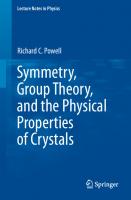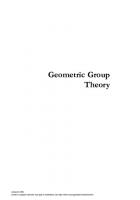Crystal Properties via Group Theory 9780521419451, 052141945X
274 51 1MB
English Pages 244 Year 1995
Table of contents :
Contents
Preface
1. Tensor properties of crystals: equilibrium properties
1-1 Definition of crystal properties
1-2 Physical quantities as tensors; tensor properties
1-3 The basic linear relations
1-4 Condensation of indices: the 'engineering' stresses and strains
1-5 Effect of changing the conditions of measurement
1-6 Higher-order effects
1-6-1 Permittivity and optical properties
1-6-2 Third-order elastic constants
1-7 Optical activity: the gyration tensor
1-8 Summary of equilibrium properties
2. Tensor properties of crystals: transport properties
2-1 General theory
2-2 Thermoelectric effects
2-3 Piezoresistance
2-4 Galvanomagnetic and thermomagnetic effects
2-5 Summary of transport properties
2-6 Properties that cannot be represented by tensors
3. Review of group theory
3-1 Crystal symmetry and the point groups
3-2 Representation theory
3-3 The character tables
3-4 Concept of symmetry coordinates
3-5 Concept of similarity of orientation
4. Linear relations treated group theoretically
4-1 Introduction and Neumann's principle
4-2 Tensor quantities as hypervectors
4-3 The Symmetry-Coordinate Transformation (S-C-T) tables
4-4 The Fundamental Theorem
4-5 Applications of the Fundamental Theorem
4-6 Alternative treatments
5. The magnetic point groups and time reversal
5-1 The magnetic point groups
5-2 Neumann's principle in space-time
5-3 Application to non-magnetic crystals
5-4 Application to magnetic crystals
5-5 Conclusions
6. Matter tensors of rank 0, 1 and 2
6-1 Scalar quantities (rank 0)
6-2 Polar vector quantities (rank 1)
6-2-1 Form of the K tensor
6-2-2 Application to pyroelectric effect; ferroelectrics
6-3 Axial vector quantities
6-4 Second-rank tensor quantities
6-4-1 Forms of the K tensor for various crystal symmetries
6-4-2 Property Kin an arbitrary direction
6-4-3 Further remarks on T(2) matter tensors
6-4-4 Application to diffusivity and electrical conductivity
6-4-5 Application to the optical indicatrix
6-4-6 Application to the Hall tensor (see Section 2-4)
6-5 Second-rank axial tensors
6-5-1 Forms of the K tensor for various crystal symmetries
6-5-2 Application to optical activity (see Section 1-7): case of quartz
7. Matter tensors of rank 3
7-1 Partly symmetric tensors of rank 3
7-1-1 Form of the K tensor for various crystal symmetries
7-1-2 Application to piezoelectricity: quartz and PZT
7-1-3 Application to the linear electro-optic effect
7-2 Non-symmetric tensors of rank 3
7-3 Axial tensors of rank 3
7-4 Polar tensors of rank 3 revisited
8. Special magnetic properties
8-1 c-tensors of rank 1: the magnetocaloric effect
8-2 c-tensors of rank 2: the magnetoelectric effect
8-3 c-tensors of rank 3: the piezomagnetic effect
8-4 Symmetric c-tensors of rank 3: higher-order magnetic permeability
9. Matter tensors of ranks 4 and 5
9-1 Relation between T_s(2) and T_s(2)
9-2 Application to the elastic constants
9-3 Some applications of non-symmetric T( 4) tensors
9-4 Relation between T_s(2) and T(2): magnetothermoelectric power
9-5 Relation between T(1) and T_S(3): the second-order Hall effect
9-6 Other possibilities involving triple products
10. Matter tensors of rank 6
10-1 Relation between T_S(2) and T_S(4)
10-1-1 Case of the upper hexagonal groups
10-1-2 Case of the upper cubic and isotropic materials
10-2 Application to third-order elastic constants
10-3 Other cases of T(6) tensors
Appendix A. Review of tensors
A-1 Linear orthogonal transformations
A-2 Defining tensors
A-3 Algebra of tensors
A-4 Symmetry of tensors
A-5 Representation quadric of a symmetric T(2)
A-6 Axial tensors
Appendix B. Stress, strain and elasticity
B-1 Stress
B-2 Strain
B-3 Elasticity
Appendix C. Finite deformation
Appendix D. The great orthogonality theorem
Appendix E. The Symmetry-Coordinate Transformation tables for the 32 point groups and two infinite groups
Appendix F. Proof of the Fundamental Theorem
Appendix G. Theorems concerning magnetic groups
References
Contents
Preface
1. Tensor properties of crystals: equilibrium properties
1-1 Definition of crystal properties
1-2 Physical quantities as tensors; tensor properties
1-3 The basic linear relations
1-4 Condensation of indices: the 'engineering' stresses and strains
1-5 Effect of changing the conditions of measurement
1-6 Higher-order effects
1-6-1 Permittivity and optical properties
1-6-2 Third-order elastic constants
1-7 Optical activity: the gyration tensor
1-8 Summary of equilibrium properties
2. Tensor properties of crystals: transport properties
2-1 General theory
2-2 Thermoelectric effects
2-3 Piezoresistance
2-4 Galvanomagnetic and thermomagnetic effects
2-5 Summary of transport properties
2-6 Properties that cannot be represented by tensors
3. Review of group theory
3-1 Crystal symmetry and the point groups
3-2 Representation theory
3-3 The character tables
3-4 Concept of symmetry coordinates
3-5 Concept of similarity of orientation
4. Linear relations treated group theoretically
4-1 Introduction and Neumann's principle
4-2 Tensor quantities as hypervectors
4-3 The Symmetry-Coordinate Transformation (S-C-T) tables
4-4 The Fundamental Theorem
4-5 Applications of the Fundamental Theorem
4-6 Alternative treatments
5. The magnetic point groups and time reversal
5-1 The magnetic point groups
5-2 Neumann's principle in space-time
5-3 Application to non-magnetic crystals
5-4 Application to magnetic crystals
5-5 Conclusions
6. Matter tensors of rank 0, 1 and 2
6-1 Scalar quantities (rank 0)
6-2 Polar vector quantities (rank 1)
6-2-1 Form of the K tensor
6-2-2 Application to pyroelectric effect; ferroelectrics
6-3 Axial vector quantities
6-4 Second-rank tensor quantities
6-4-1 Forms of the K tensor for various crystal symmetries
6-4-2 Property Kin an arbitrary direction
6-4-3 Further remarks on T(2) matter tensors
6-4-4 Application to diffusivity and electrical conductivity
6-4-5 Application to the optical indicatrix
6-4-6 Application to the Hall tensor (see Section 2-4)
6-5 Second-rank axial tensors
6-5-1 Forms of the K tensor for various crystal symmetries
6-5-2 Application to optical activity (see Section 1-7): case of quartz
7. Matter tensors of rank 3
7-1 Partly symmetric tensors of rank 3
7-1-1 Form of the K tensor for various crystal symmetries
7-1-2 Application to piezoelectricity: quartz and PZT
7-1-3 Application to the linear electro-optic effect
7-2 Non-symmetric tensors of rank 3
7-3 Axial tensors of rank 3
7-4 Polar tensors of rank 3 revisited
8. Special magnetic properties
8-1 c-tensors of rank 1: the magnetocaloric effect
8-2 c-tensors of rank 2: the magnetoelectric effect
8-3 c-tensors of rank 3: the piezomagnetic effect
8-4 Symmetric c-tensors of rank 3: higher-order magnetic permeability
9. Matter tensors of ranks 4 and 5
9-1 Relation between T_s(2) and T_s(2)
9-2 Application to the elastic constants
9-3 Some applications of non-symmetric T( 4) tensors
9-4 Relation between T_s(2) and T(2): magnetothermoelectric power
9-5 Relation between T(1) and T_S(3): the second-order Hall effect
9-6 Other possibilities involving triple products
10. Matter tensors of rank 6
10-1 Relation between T_S(2) and T_S(4)
10-1-1 Case of the upper hexagonal groups
10-1-2 Case of the upper cubic and isotropic materials
10-2 Application to third-order elastic constants
10-3 Other cases of T(6) tensors
Appendix A. Review of tensors
A-1 Linear orthogonal transformations
A-2 Defining tensors
A-3 Algebra of tensors
A-4 Symmetry of tensors
A-5 Representation quadric of a symmetric T(2)
A-6 Axial tensors
Appendix B. Stress, strain and elasticity
B-1 Stress
B-2 Strain
B-3 Elasticity
Appendix C. Finite deformation
Appendix D. The great orthogonality theorem
Appendix E. The Symmetry-Coordinate Transformation tables for the 32 point groups and two infinite groups
Appendix F. Proof of the Fundamental Theorem
Appendix G. Theorems concerning magnetic groups
References

- Author / Uploaded
- Arthur S. Nowick

![Lectures on the Theory of Group Properties of Differential Equations [0.0]
9789814460811](https://ebin.pub/img/200x200/lectures-on-the-theory-of-group-properties-of-differential-equations-00-9789814460811.jpg)







